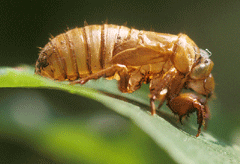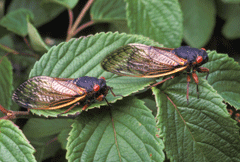
Cicada nymph (Courtesy of USDA)
Adult Cicadas (Courtesy of USDA)
After seventeen years of hibernation, the cicadas of Brood XIII in Illinois recently re-emerged. Commentator Tom Montgomery-Fate has been watching them in his backyard in suburban Chicago, with a sense of wonder about their--and our--purpose.
GELLERMAN: It’s been a big sleep, but now they’re wide-eyed, bushy-winged and back in droves. In northern Illinois, the 17-year cicadas are re-emerging from their long underground snooze. And commentator Tom Montgomery-Fate has been watching them in his backyard in suburban Chicago wondering whether the cicada’s short but dramatic lives offer a bit of insight into our own.
MONTGOMERY-FATE: All spring I noticed the little holes appearing in our rose bed. They are the openings to the finger-sized mud chimneys where thousands of cicada nymphs had been waiting for the moment their bodies would “know” they should leave. After 17 years of waiting in the darkness and sipping from tree roots, the moment finally arrived.

Cicada nymph (Courtesy of USDA)
This explosion of cicada - roughly a half million of them per acre—has prompted a range of emotions from my neighbors - from joy to disgust. Some are repulsed by the swarms of bugs clinging to their bushes and flowers, or falling out of trees into their hair during an evening stroll.
But others, like me, see the cicada as the genius of nature: 17 years of patience, of waiting underground, followed by a few weeks of passion, of sunlight and sex, of birthing and dying. This seeming imbalance between patience and passion is misleading. The rare abundance of the cicada evolved to overwhelm their predators, who simply can’t eat them all. The patience and passion has a purpose, and it has worked for thousands of years.

Adult Cicadas (Courtesy of USDA)
I shift my attention back to the ancient chorus in the backyard, and strain to hear something hopeful amid the cacophony, something I can trust. I try to remember that we and the cicada are related, and to believe that that matters, and that it is never too late to crawl out of the darkness into the stunning possibilities of the sunlight.
[MUSIC: Sleepytime Gorilla Museum “The 17-Year Cicada” from ‘Of Natural History’ (Web Of Mimicry – 2004)]
GELLERMAN: Tom Montgomery-Fate teaches writing at College of DuPage in Glen Ellyn, Ill. He’s the author of the memoir, “Steady and Trembling.”
Links http://www.cod.edu/dept/lart/montgomery_fate.htm - Tom Montgomery-Fate, Professor of English, College of DuPage http://www.chicagotribune.com/news/specials/broadband/chi-cicada-map-html,0,1315785.htmlstory - Chicago Tribune Cicada Map http://www.cicadamania.com/cicadas/ - Cicada Mania website